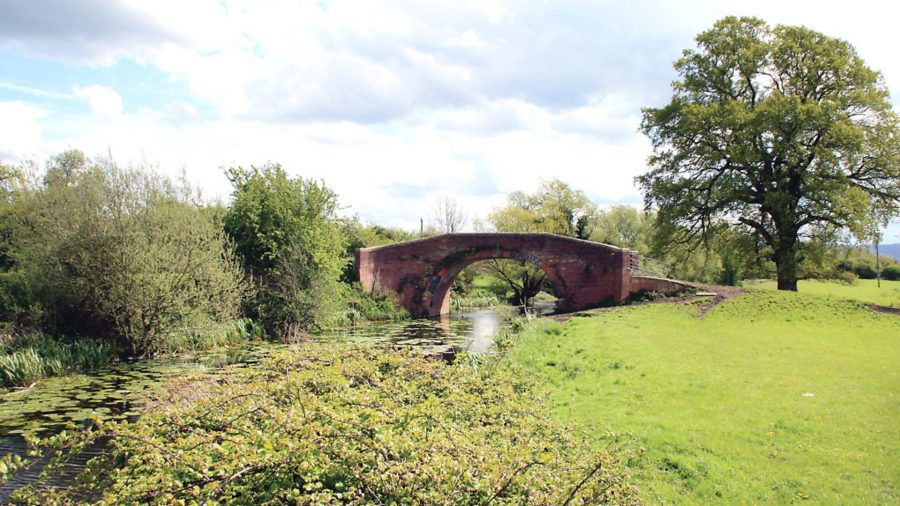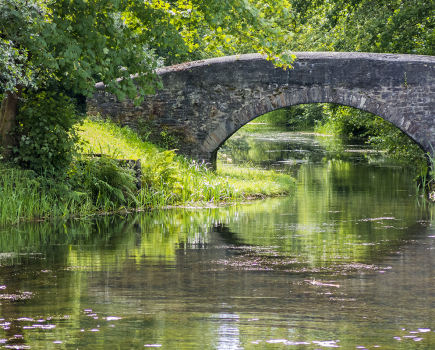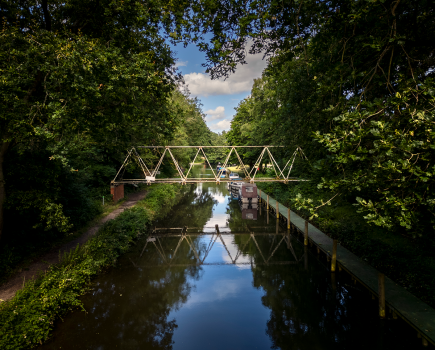All being well, boats will be cruising the first ten miles of the Cotswold Canals in the not too distant future. We look at the background to the £23m restoration programme, and the work to be done…

The first short length leading west from Saul Junction is already used for moorings
The Cotswold Canals are set to be re-connected to the national waterways network thanks to provisional agreement of £10m of Lottery funding towards a £23m restoration funding package: that’s the big news this year for waterways restoration, and we’ve covered it on our news pages. In this article, we’re going to go into the detail of what exactly that money will buy. What’s actually involved in spending £23m on the four-mile Phase 1b length of canal from Saul Junction to Stonehouse?
But first we owe you an explanation of the various ‘phases’ that are mentioned in connection with the Cotswold restoration – what are they, what order are they being restored in, and why?
It began with an acceptance by those supporting the restoration that (unlike the Millennium restorations such as the Rochdale and the Huddersfield), in the case of the Cotswold Canals it was unlikely that any sources of funding would come up with the sums needed to complete the entire restoration in one go. Sure, no individual problem was any worse than had been dealt with on other canals. But with numerous main road and rail crossings, a collapsed two-mile tunnel and several missing lengths of waterway, and the sheer length and complexity of the job, the cost of reopening the Stroudwater Navigation and the Thames & Severn Canal all the way through from Saul on the Gloucester & Sharpness Canal to Inglesham on the Thames added up to just too much.
So Cotswold Canals Trust divided it into three: Phase 1 was the western length from the Gloucester & Sharpness Canal through Stroud and on to Brimscombe Port, the former inland transhipment basin where the gauge of the locks changed, and where once Severn Trows and upper Thames barges exchanged cargoes. Phase 2 was the eastern section from the Thames to the Cotswold Water Park, a large leisure area created from flooded former gravel pits. And Phase 3 was the central section linking these two sections via the steep climb via the many locks from Brimscombe up the Golden Valley to Sapperton Tunnel, then the gentler descent to the Water Park.

Whitminster Lock needs some restoration work
Although not necessarily the easiest in technical terms, Phase 1 had the advantage that most of it was still in the ownership of the original Stroudwater company, there were enough restorable historic structures to make it a ‘heritage’ project, and its route through Stroud’s former mill valley would tick the boxes for any ‘regeneration’ support. On the down side, it was blocked by the Birmingham to Bristol main railway line, the M5 motorway and the A38 main road; a whole ‘missing mile’ west of Eastington had been obliterated; and a length just east of Stroud would need to be diverted where its course had been used for the town’s bypass and former rubbish tip (albeit a diversionary route had been reserved).
So Phase 1 was chosen as the subject of the first major funding bid. But an initial approach to the Heritage Lottery Fund for a grant in the region of £22m to provide the bulk of the funding received a reply which might be summarised along the lines of “Sorry but we don’t have the resources for a grant of that size: come back with a bid for half that amount, and we’ll see what we can do.”
This left the canal restorers with a dilemma: if they could only restore half of Phase 1, which half should it be? To many canal boaters the answer seemed obvious: opening up the western end from Saul, and then using that as a springboard for further progress eastwards to Stroud and beyond, made a lot more sense than opening an isolated length limited to local boats and small craft which would then need to be linked to the national network at a later date.
But the HLF and other potential funders weren’t primarily interested in narrowboating. The HLF’s interest was heritage – and there was relatively little heritage work to be done in the western four miles. Five of the six surviving historic locks on this length had already at least been partly restored, and the work still to be done was more about finding engineering solutions to the M5, A38 and rail crossings and building a mile of new canal with two new locks to replace the missing length. Likewise the other likely funders, the regional development agency, Stroud District Council and other local authorities, were more interested in urban regeneration and long-term job creation – of which there also wasn’t a great deal on the western part.

An overgrown but intact length of canal near Whitminster
By contrast the eastern six miles of Phase 1, from Stonehouse to Brimscombe, included numerous surviving locks and bridges to restore, and ran through a former mill valley with a great deal of regeneration potential and immediate benefits for local people. As such it ticked all the boxes for the big funders – and so, to a certain amount of disappointment among boating folks, the Trust plumped for the eastern section, dubbed ‘Phase 1a’. And sure enough, the funders supported it to the tune of over £20m in total.
Fast forward a few years, and despite a few wobbles along the way (including British Waterways’ withdrawal from the partnership; the need to drop the uppermost length near Brimscombe when the economic downturn meant that commercial redevelopment of the Port was no longer going to pay for it; and a much greater volunteer involvement required to make up for a funding shortfall), it’s now very nearly complete. New main road bridges and several smaller liftbridges have been built, the Stroud diversion completed, nine locks restored and re-gated, the channel dredged.
And in the meantime, Phase 1b (as the western four miles linking to Saul Junction have been named) has not been forgotten. Once again the HLF was seen as the potential major funder, but the regional development agencies no longer exist, so more of the matching funding would have to come from local authorities and other sources – including CCT and the Canal & River Trust, which has returned several years after the departure of predecessor BW.

This length near Whitminster needs some channel clearance
So why should HLF fund this length, when the wisdom some years ago was that they would be put off by the lack of heritage value? Well, as Stroud District Council puts it “Our support for the project is demonstrated by our leadership of Phase 1A restoration and the £4 million which we committed to it. Phase 1B will realise the full benefits of this investment.” While the work might not be of great heritage interest, it would help to secure the future of the historic length already restored, because visiting boats would bring in income for the canal and the community.
And despite the first bid in 2015 being turned down, the success of last year’s revised application in passing its first major hurdle appears to show that this approach has been successful.

This farm bridge near Eastington survives, although the canal has been filled in
So assuming it passes the second hurdle and the full £23m package can be assembled, what will the restoration involve in practical terms? You can see for yourself if you fancy a walk – much of the route can be followed on foot, starting at Saul Junction where it leaves the Gloucester & Sharpness.
The first length from the junction is fully navigable and used for moorings (as well as for access to Saul Marina), but soon comes to a stop at Walk Bridge, which carries a minor road across at just above water level and will need to be replaced with a high level bridge or opening structure. A clear length of channel beyond leads to Whitminster Lock, partly restored but looking somewhat overgrown and with a dam across the chamber. Beyond, the canal and the River Frome share a course for some distance, and this length will need some flood control works plus a new junction where the canal diverges to the left from the river.

Blunder Lock and Newtown Lock were restored some years ago
A well-preserved (but in some places overgrown) length follows, and while one farm bridge has been replaced with a low level culvert and will need rebuilding, a second one survives in good condition. This length comes to an end at the first of the ‘big three’ obstructions: the A38, which at this point meets the A419 at a roundabout. The remarkable solution is for the canal to cross the roundabout on the diagonal via two new bridges. [Update: since this was written the new bridges have been funded by Highways England and built, see our article]
Beyond is the start of the ‘missing mile’ – there is little sign of the canal, and anyway a diversion is needed to cope with the second major blockage, the M5. A new length of canal will bear off to the right from its original route, passing through a new lock before coming alongside the River Frome. The canal will squeeze beside the river as the two watercourses pass under the motorway side-by-side using the existing river bridge – again with some flood control implications – before they part company again.

The restored section between Eastington and Stonehouse
Rising through a second new lock, the new canal channel will return to the original course to pass through another surviving farm bridge. This is followed by the start of a flight of five locks: the first (Westfield Lock) lies buried and part demolished, with a stream cutting through the canal bed above the lock which will need a small aqueduct. But the next two locks (Dock and Pike) are partly restored, the adjacent Pike Bridge road crossing was rebuilt several years ago, and the final two locks (Blunder and Newtown) were put back into working order many years ago, when this rewatered length saw regular use by the Trust’s trip-boat.
This restored length continues through several further bridges, including the unusual Bonds Mill Bridge, a liftbridge rebuilt in the 1990s as a not entirely successful experiment in the use of advanced structural plastics which will need some further work.

Since this article was written, this railway blockage has been replaced by a new bridge with full navigable headroom over Christmas 2021
This well-kept length of channel (benefiting from recent attention by visiting Waterway Recovery Group volunteers including last winter’s Christmas Canal Camp) leads to the third and final major obstacle: the Birmingham to Bristol main line railway. The towpath is well catered for with a tunnel through the railway embankment, but the canal passes through a culvert barely big enough for a work punt. Agreement will need to be reached with Network Rail about how to insert a navigable sized culvert through the embankment with the minimum of (costly) disruption to train services. [Stop press: since this article was written, the new railway bridge has been built during a railway closure over the Christmas 2021 holiday period]
And beyond the railway is the wide known as ‘The Ocean’, the end of Phase 1B, and the start of almost six miles of restored Phase 1a length leading to Stroud and beyond.

Since this photograph was taken, the new bridges carrying the canal under the A38 roundabout have been built, funded by Highways England
So if the complete funding is confirmed, how long will it take? We spoke to Cotswold Canals Trust, and the reply was that boats could be cruising through to Stroud around 2024.
But that won’t be the end of matters. Firstly there’s the unfinished business at Brimscombe Port, dropped from Phase 1a because commercial developers were no longer in a position to pay to restore the canal as part of a regeneration scheme. Following grants from the Government Homes & Communities Agency and more recently £1.6m from Stroud District Council, the hope is that this can now be put back on track with the same 2024 completion target.

A new canal channel will be squeezed alongside the River Frome where it passes under the M5 motorway
And then what? There are still 26 miles to restore to reach the Thames, but work is already in progress at various points along the line. At the east end Inglesham Lock is well on the way to completion thanks to a funding appeal several years ago by the Inland Waterways Association. On the lengths between Cerney and Eisey a great deal of mainly volunteer restoration has already been completed including several locks and bridges, and work continues on Weymoor Bridge. And CCT will be on the lookout for any further opportunities to progress the restoration as they arise.
But despite this progress, there will doubtless need to be further major funding applications in the future to deal with the more serious blockages – not least, Sapperton Tunnel.
However, to go back to the start of this article when we explained that the phased approach to restoration was a result of a perception that it was just to big and complex to be funded in one go: there’s just a chance that that might not be the case after all. Thames Water is still looking at ways to move drinking water supplies from the Severn to the Thames, and while it isn’t currently the favoured option, doing it by restoring the canal as a water transfer channel isn’t entirely out of the question. And that could see the entire canal reopened to through navigation.
Image(s) provided by:
Martin Ludgate






